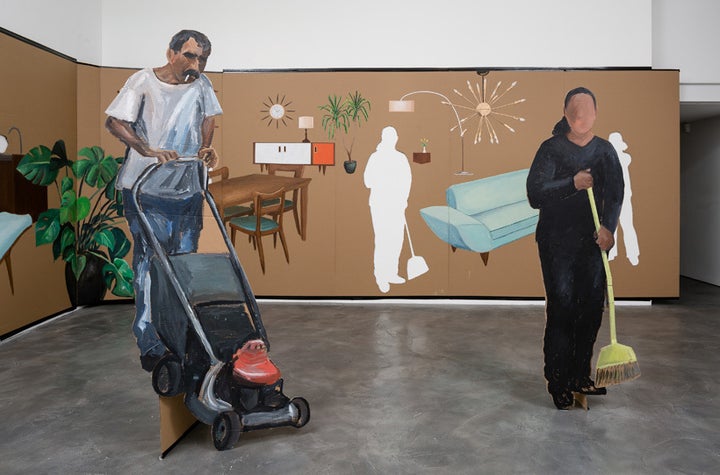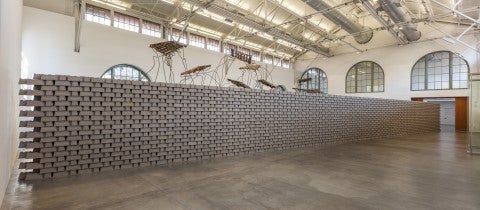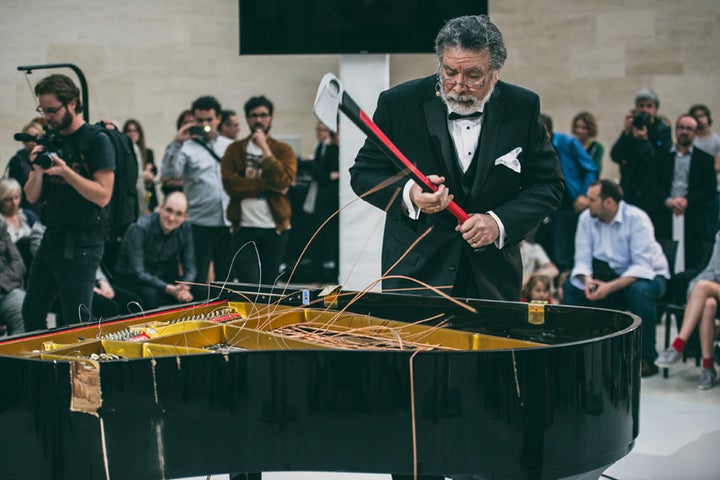
Ramiro Gomez, Cut-Outs. Charlie James Gallery, December 12, 2015 - January 2, 2016.
Cardboard. It’s everywhere, yet we do not see it for what it is: the cobblestone or brick of a global consumer culture. Consider the reach of cardboard across our society. It’s a cereal box, a greeting card, a book cover, a container for personal and business documents. It’s the appliance box that became my first and only spaceship when I was six years old. It’s what makes the digital age possible, from the ubiquitous boxes of online commerce to Google Cardboard, which turns your smartphone into a virtual reality experience. It’s the material for designer furniture and architecture, starting with Frank Gehry’s Wiggle Chair in 1972. It’s the communication system and shelter for the homeless. It’s a picket sign. It’s the canvas for an art of protest.
When the LA Art Show (LAAS) approached me about curating several works for a special program as part of the international art fair at the Los Angeles Convention Center, January 11-15, 2017, I thought about cardboard. The special program focused on installation and performance art engaged with the Latino and Latin American experience. It is no exaggeration to say that the public discourse around that experience had been fixated on border walls and mass deportations over the previous year. If there was a debate, the terms of that debate seemed be how tall a wall to build, how many people to deport, and who will pay. This was not the first time: in the 1930s, similar discussions led to the Mexican Repatriation program and in the 1950s, Operation Wetback. Both programs resulted in Mexican Americans being “returned” to Mexico. Ironically, as ABC News reported, over the last eight years “the Obama administration has deported more people than any other president's administration in history.” Coincidentally, the LAAS takes place the week before the inauguration of Donald Trump as the next President of the United States. The timing seems right for cardboard.
And so, I turned to large-scale works by Southern California artists Ramiro Gomez and Louis Hock that make visible the de-humanizing nature of the ongoing immigration debate. At the LAAS, the two works that will be on display by these artists are each eight feet tall and (combined) run nearly 170 feet in length. Gomez’s Cut-Outs is a striking installation with two primary components: a mural of modern domestic scenes that one would expect to see in home décor magazines, and, cut out from the mural and positioned in front of it on the gallery floor, figures that are essential to these spaces and yet are never depicted: Latino domestic workers. Meanwhile, Hock’s a wall evokes President-elect Trump’s proposed border wall between the US and Mexico. This wall halves the 50,000-square-foot space where performances and installations will be exhibited and, more critically, confronts and disorients visitors by interrupting the natural flow of foot traffic. Both works are constructed from cardboard, in the form of corrugated fiberboard and bricks of recycled paper pulp.

Louis Hock, a wall (2016). Installed at Museum of Contemporary Art San Diego, Downtown location, August 18- September 27, 2016.
These works are inherently disposable, adding another dimension to the issues the artists engage. They are not making objects to contemplate from a safe distance, and for all time, but rather initiating a process in the present moment that brings the issue close to home. Rounding out that experience will be three performances by veteran East Coast artist Raphael Montañez Ortiz. These performances will engage ritualistic and participatory practices focused on the everyday objects that often structure and hold our anxieties: our furniture, our food, pocket change, and paper. But he is not performing for an audience, but rather engaging attendees in the ritual use of destruction as a basis for social action. As the artist writes, “There is Passive ART and Active ART. Active ART requires you to participate.”

Raphael Montañez Ortiz, Piano Destruction Concert: Dance Number One. Mudam Luxembourg, July 11, 2014.
During the protests in Paris in May 1968, graffiti with the slogan “Sous les pavés, la plage!” (Under the cobblestones, the beach!) served as a poetic directive to protesters to dig up the city’s cobblestone roads and throw the stones at the police. The “beach” was the layer of sand upon which the cobblestones rested. As the Financial Times noted:
“Literally, it was taken as a reference to sand found beneath the cobblestones lifted by students to hurl at the police. Its real roots lie in the ideas of an obscure, fluid, hugely influential movement called the situationists and their conviction that the city streets, the expression of capital and consumption, could be rediscovered and subverted through a new praxis of aimlessness, of drifting through them discovering new connections and revealing unexpected histories.”
But the beach was not just a tactical symbol or a strategy for gathering urban research (what the situationists called dérive). It was also a utopian destination, where the sand meets the water, and where change is inevitable. Stones and sand, bricks and mortar—the building blocks for civilization. But cardboard and internet? We tend to think of the digital era as one that has left the material world behind. Now we go to another beach, different from the one evoked in May 1968: we surf the web. And unlike the cobblestones and bricks of earlier societal infrastructures, cardboard is discarded once the object it contains has been unwrapped.
Yet artists today understand: “Under the cardboard, the beach.”
NOTE: Gomez and Ortiz’s works are presented under the rubric “Fragments from Home” through the Los Angeles County Museum of Art (LACMA), and represent a preview of two artists in the upcoming exhibition Home—So Different, So Appealing organized by the UCLA Chicano Studies Research Center (CSRC) for LACMA. I am co-curator of that exhibition with Pilar Tompkins Rivas (Vincent Price Art Museum) and Mari Carmen Ramírez (Museum of Fine Arts, Houston). The exhibition opens June 2017 and is part of Pacific Standard Time: LA/LA, an initiative of the Getty with arts institutions across Southern California. Hock’s a wall is presented through the CSRC. All three artists are among the roughly three-dozen artists, arts professionals, and arts organizations whose papers are among the 160 collections archived by the CSRC Library.

Raphael Montañez Ortiz, Piano Destruction Concert: Dance Number One. Mudam Luxembourg, July 11, 2014.
